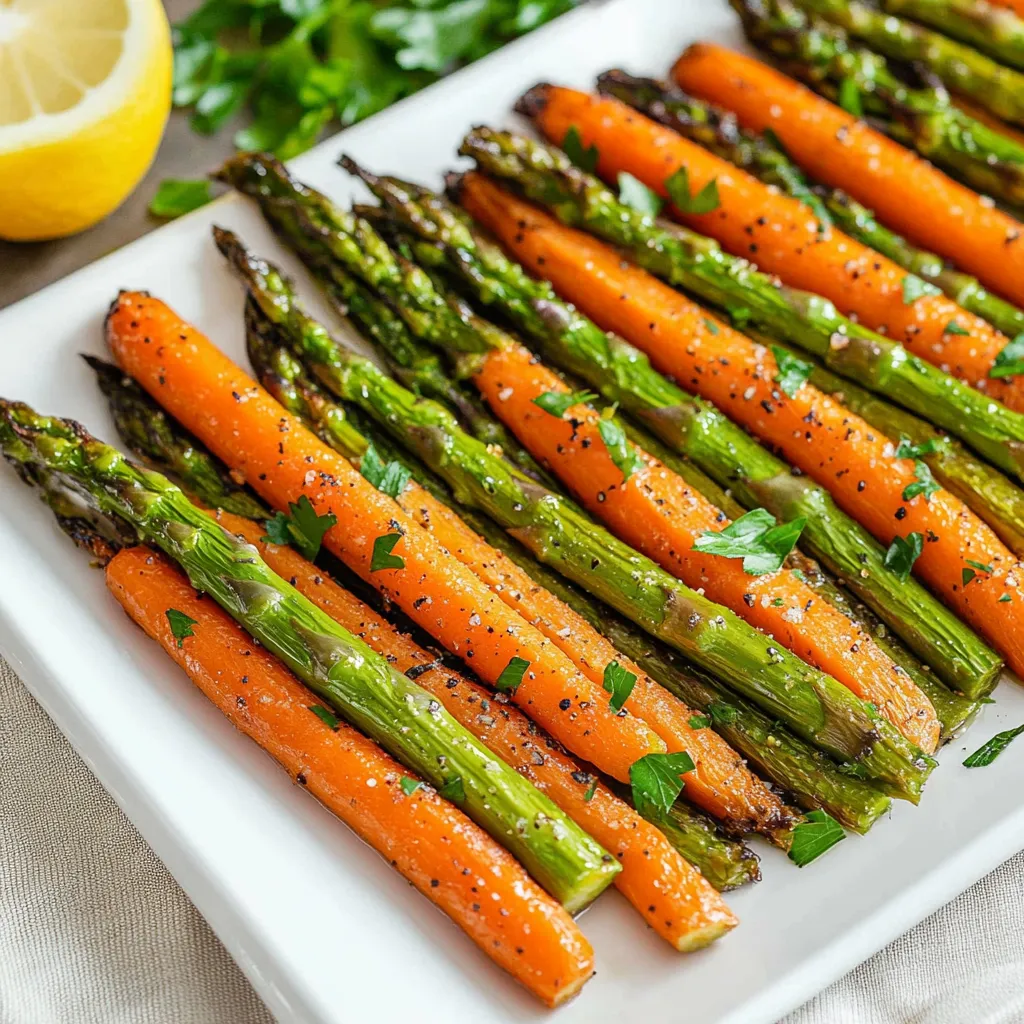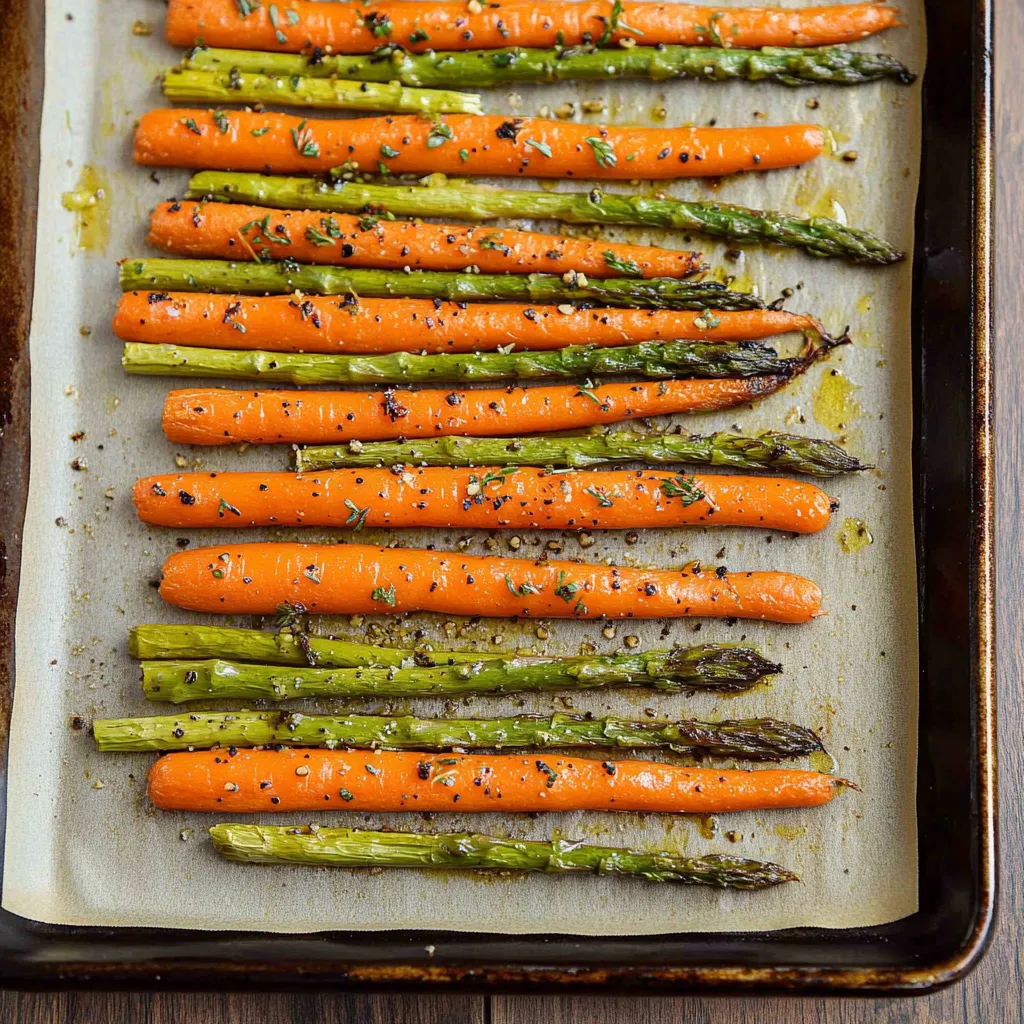 Pin it
Pin it
This roasted asparagus and carrots dish transforms ordinary vegetables into a caramelized, flavor-packed side that pairs perfectly with almost any main course. The magic happens when the natural sugars in the carrots and asparagus concentrate and caramelize in the oven, creating sweet, tender morsels with slightly crisp edges. Simple yet sophisticated, this nutritious side dish requires minimal effort but delivers maximum flavor in just 20 minutes from start to finish.
I stumbled upon this combination one spring evening when I had both vegetables on hand but not enough of either for a full side dish. Rather than preparing them separately, I decided to roast them together, matching the carrots' thickness to the asparagus for even cooking. My husband, typically indifferent to vegetable sides, asked for seconds and then requested I make this again the following night! Now it's our go-to side dish for everything from casual weeknight dinners to holiday feasts. The bright colors and flavors never fail to impress guests, who are often surprised by how such a simple preparation can taste so delicious.
Ingredients
- 1 bunch fresh asparagus (about 1 pound): Look for medium-thick stalks with tight, closed tips and vibrant green color
- 3-4 medium carrots or 8-10 baby carrots: Choose young, sweet carrots that can be sliced to match the asparagus thickness
- 2 tablespoons olive oil: Helps the vegetables caramelize and carries the flavors of the seasonings
- ½ teaspoon kosher salt: Enhances the natural flavors without overpowering them
- ¼ teaspoon freshly ground black pepper: Adds a subtle warmth and depth
- 1 tablespoon fresh lemon juice: Brightens the flavors and balances the natural sweetness
- Optional seasonings: Garlic powder, herbs de Provence, or paprika can add additional layers of flavor
- Fresh parsley for garnish: Adds a pop of color and fresh herbaceous notes
Step-by-Step Cooking Instructions
- Step 1:
- Prepare your oven and baking sheet: Preheat your oven to 400°F (200°C). This temperature is the sweet spot for roasting vegetables – hot enough to caramelize their natural sugars but not so hot that they burn before cooking through. Line a large baking sheet with parchment paper or aluminum foil. The lining not only prevents sticking but also makes cleanup a breeze. I prefer parchment for its naturally non-stick properties, but foil works well too.
- Step 2:
- Prep the asparagus: Hold one asparagus spear at both ends and gently bend until it snaps naturally. This magical breaking point is where the tough, woody part ends and the tender, delicious part begins. Use this spear as a guide to trim the rest of the bunch with a knife, or snap each one individually if you prefer. This method ensures you're only eating the tender part of the asparagus, avoiding that unpleasant fibrous texture that can ruin the dish.
- Step 3:
- Prepare the carrots: Wash and peel the carrots if needed (young or baby carrots often don't require peeling). Slice them on the diagonal into pieces approximately the same thickness as your asparagus spears – about ¼ inch thick. The diagonal cut not only creates pieces similar in size and shape to the asparagus but also increases the surface area for better caramelization. Matching the thickness is crucial for ensuring both vegetables cook at the same rate.
- Step 4:
- Season the vegetables: Place the trimmed asparagus and sliced carrots on your prepared baking sheet. Drizzle with olive oil and sprinkle with salt and pepper. Use your hands to toss everything together, ensuring each piece is evenly coated with oil and seasonings. This hands-on approach, while a bit messy, does a better job of coating the vegetables than using utensils. Arrange the vegetables in a single layer with a bit of space between pieces – overcrowding leads to steaming rather than roasting.
- Step 5:
- Roast to perfection: Place the baking sheet in the preheated oven and roast for 15-20 minutes. The exact timing will depend on the thickness of your asparagus and how you like your vegetables cooked. I prefer mine with a slight bite rather than completely soft, which usually takes about 18 minutes in my oven. The vegetables are done when they're tender enough to easily pierce with a fork, but not so soft that they've lost all structure. The tips of the asparagus should be slightly crispy, and you should see some caramelization on the surface of both vegetables.
- Step 6:
- Finish with bright flavors: Remove the baking sheet from the oven and immediately squeeze fresh lemon juice over the hot vegetables. The heat helps the lemon juice permeate the vegetables, brightening their flavor. If you're using any additional seasonings or garnishes, add them now while the vegetables are still hot. For a special touch, consider a sprinkle of freshly grated Parmesan cheese, which will slightly melt onto the hot vegetables, or a drizzle of balsamic glaze for a tangy-sweet finish.
- Step 7:
- Serve immediately: Transfer to a serving dish, garnish with fresh parsley if desired, and enjoy while hot. These vegetables are at their peak when fresh from the oven, with the perfect contrast between caramelized exteriors and tender interiors. While they're still delicious at room temperature, the textural contrast is most pronounced when they're freshly roasted.
 Pin it
Pin it
The Secret to Perfect Roasted Vegetables
The difference between good roasted vegetables and great ones lies in a few simple but crucial techniques that I've perfected over years of vegetable roasting.
First, the size and uniformity of your vegetable pieces dramatically impacts how they cook. When I first made this dish, I didn't pay much attention to matching the thickness of the carrots to the asparagus. The result? Perfectly tender asparagus but still-crunchy carrots. Now I make sure to slice the carrots thin enough – about ¼ inch – so they cook at the same rate as the asparagus. This simple step ensures every bite offers perfectly cooked vegetables.
The baking temperature is another crucial factor. At 400°F, the vegetables roast at the ideal rate – hot enough to caramelize their natural sugars without burning the exterior before the interior cooks through. I've tried higher temperatures to save time, but the results are never as good – the outside burns while the inside remains too firm.
Finally, don't underestimate the power of proper spacing on your baking sheet. When vegetables are crowded, they release moisture and steam each other instead of roasting and caramelizing. A single layer with a bit of breathing room between pieces allows hot air to circulate around each vegetable, creating those delicious browned edges that make roasted vegetables irresistible.
Last Easter, I served this dish alongside our traditional ham, and my mother-in-law – who typically politely declines vegetable dishes – not only took a serving but asked for the recipe before dinner was over! She later confided that she'd never been a fan of asparagus until trying this preparation, which changed her mind about the vegetable entirely. Now when she visits during spring, she specifically requests "that roasted asparagus dish," which is high praise indeed from someone who once claimed not to like vegetables.
Delicious Variations to Try
While the basic recipe is delicious on its own, I love experimenting with different flavor profiles to complement various main dishes. Here are some variations that have become favorites in our household:
For an Italian-inspired version, sprinkle the vegetables with a teaspoon of Italian seasoning before roasting. After they come out of the oven, top with a quarter cup of freshly grated Parmesan cheese and return to the oven for 2-3 minutes until the cheese melts and begins to crisp around the edges. This variation pairs beautifully with grilled chicken or pasta dishes.
For an Asian flair, replace the olive oil with sesame oil and add a teaspoon of grated fresh ginger to the vegetables before roasting. After roasting, drizzle with a mixture of equal parts soy sauce and honey, then sprinkle with sesame seeds. This version complements teriyaki salmon or stir-fried dishes wonderfully.
When I'm serving this alongside a hearty roast or steak, I like to add robust herbs like rosemary and thyme before roasting, then finish with a pat of compound butter made with roasted garlic. The butter melts over the hot vegetables, creating a rich, savory coating that stands up to the stronger flavors of red meat.
I've been perfecting this simple yet sophisticated side dish for nearly five years now, tweaking techniques and trying different seasoning combinations with each preparation. What started as a practical solution for using up two partial bunches of vegetables has become one of my signature dishes, requested by family and friends for everything from casual dinners to holiday gatherings. There's something deeply satisfying about transforming humble vegetables into something so delicious that even dedicated vegetable-avoiders come back for seconds.
Frequently Asked Questions
- → Can I use baby carrots instead of regular carrots?
- Yes, baby carrots work great! Just slice them lengthwise to match the thickness of your asparagus spears for even cooking.
- → How do I know when the veggies are done?
- They should be fork-tender but still have a slight bite - not mushy. The asparagus will be bright green and the carrots will be softened.
- → What's the best way to store leftovers?
- Cool completely, then store in an airtight container with a paper towel underneath to absorb moisture. They'll keep in the fridge for 3-4 days.
- → Can I add other vegetables to this recipe?
- Absolutely! Bell peppers, zucchini, or red onions work well. Just make sure to cut them to a similar size for even cooking.
- → What's the best way to reheat these veggies?
- Reheat in a 375°F oven or air fryer until hot. Avoid microwaving as it will make them mushy.
